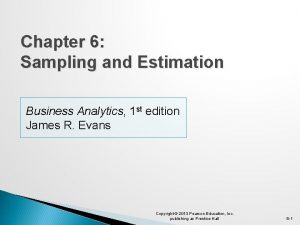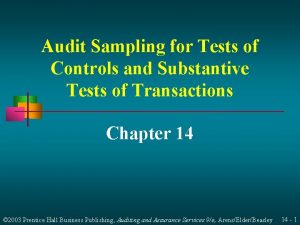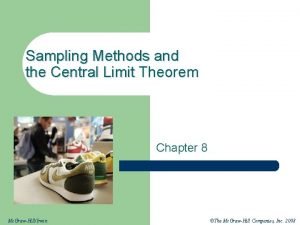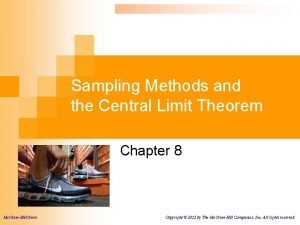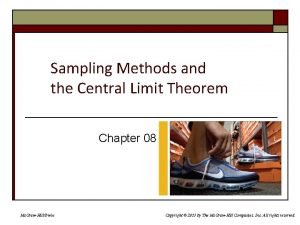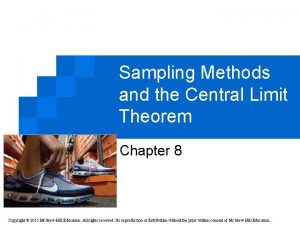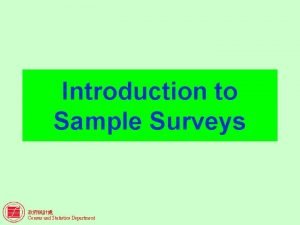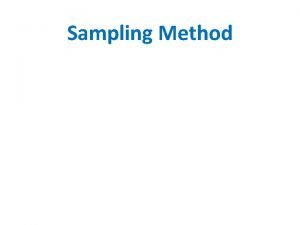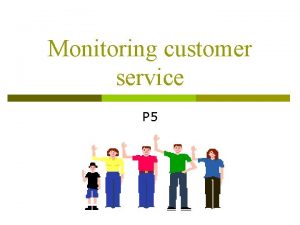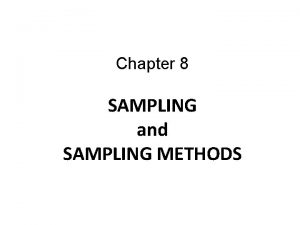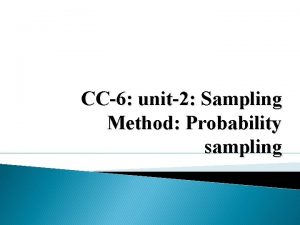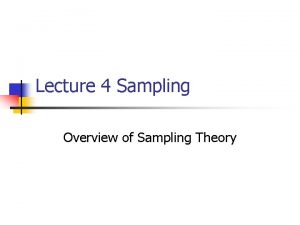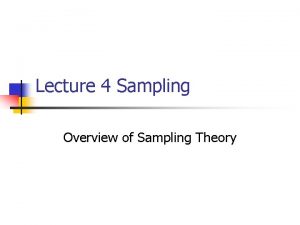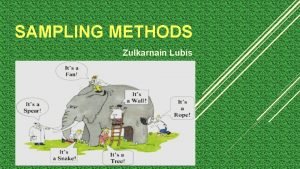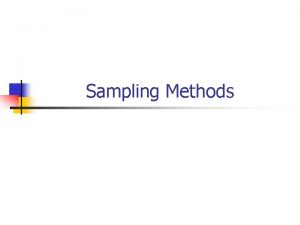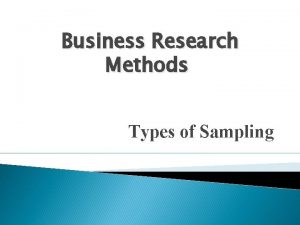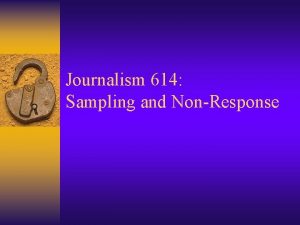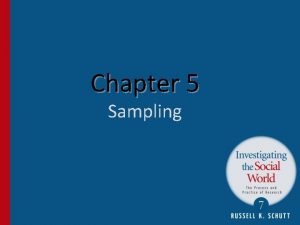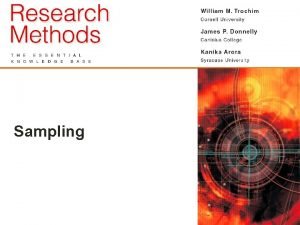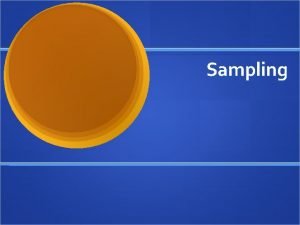SOURCE MONITORING An Overview of VOC sampling methods




















- Slides: 20

SOURCE MONITORING An Overview of VOC sampling methods and reporting in South Africa Presented by Gerald Woollatt LEVEGO Stationary Source Emission Measurement Specialists

Overview l l l l Volatile Organic Compounds (VOC’s) what are they? Classification of VOCs – as per UK, EA - TGN: M 16 Relevant standards and legislation regarding VOC’s monitoringfor stack gas emissions - a South African perspective An overview of the sampling methodology /techniques Reporting criteria Current challenges in South Africa Question and answer session

VOCs what are they? l Volatile organic compounds (VOCs) are organic chemicals that have a significant vapour pressure at room temperature and as a result have a low boiling point l Typically classified as organic compounds that have a boiling point lower than 250 o. C l They are organic compounds that easily release vapours or gases into the air we breathe

VOCs what are they? contd. l Significant build up in the atmosphere can harm human health and cause damage to the receiving environment l Common examples of VOCs that may be present in our daily lives are: benzene, ethylene glycol, formaldehyde, methylene chloride, tetrachloroethylene, toluene, xylene, and 1, 3 butadiene.

Classification of VOCs as per the United Kingdom Environment Agency, technical guidance note M 16 – Monitoring volatile organic compounds in stack gas emissions l Classified according to potential harmfulness namely: – Highly harmful – examples; benzene, vinyl chloride. These substances are known to be carcinogenic, mutagenic or toxic. – Class A compounds – Carry a lower albeit a significant risk, suspected carcinogens, contribute substantially to photochemical ozone. Examples; trichloroethylene, benzyl chloride – Class B compounds – Remaining majority of VOCs are considered as having a lower degree of harm examples; butane and ethyl acetate

Relevant legislation and methods in South Africa National Environmental Management: Air Quality Act (Act No. 39 of 2004) sets out the relevant VOC emission limits for new and existing plants under the section 21 regulations for listed activities. l The current limits vary significantly per subcategory described in the regulations l A variety of methods are currently utilised and contained under the section 21 regulations namely: l – US EPA Methods 18, 25 A and 25 B

How do we specify the concentration of VOCs? l There are three commonly used ways of reporting the concentrations of VOCs: – The concentration of the individual VOCs – currently defined in NEMA as the TO 14 suite of compounds, USEPA Method 18 as reference method – The sum of the concentrations of specific, individual VOCs in the samples, USEPA Method 18 as reference method – As total organic carbon (TOC), which is the concentration of organic carbon in the gas stream, USEPA Method 25 A as reference method

VOCs vs TOCs – Volatile organic compounds - speciated Volatile organic compound (VOC) measurements are typically determined using sampling and testing procedures as described in US EPA Method 18 “Measurement of Gaseous Organic Compound Emissions by Gas Chromatography” l Samples are collected in Tedlar, or similar bags, charcoal tubes or gas canister's and the major organic components of the gas mixture are separated by gas chromatography (GC) and individually quantified by mass spectrometry. The retention times of each separated component are compared with those of known compounds in the TO 14 VOC suite under identical conditions. Commercially available standard mixtures are used to calibrate the GC under the same conditions as those of the samples l

VOCs vs TOCs – Total organic carbon (TOC) concentration measurements are typically determined using sampling and testing procedures as described in US EPA Method 25 A “Determination of Total Gaseous Organic Concentration Using a Flame Ionization Analyser”. This method is applicable for the determination of total gaseous organic concentration of vapours consisting primarily of alkanes, alkenes, and/or arenes (aromatic hydrocarbons). The concentration is expressed in terms of propane (or other appropriate organic calibration gas) or in terms of carbon l A gas sample is extracted from the source through a heated sample line and glass fibre filter to a flame ionisation detector (FID). Results are reported as volume concentration equivalents of the calibration gas or l

Sampling techniques for monitoring TOC – FID Flame Ionisation Detectors – SRM USEPA 25 A This technique works by a gas being passed into a measurement chamber which uses a flame to create ions from VOCs • FIDs do not differentiate between different compounds since they respond to the total charge generated from the ions produced by this technique and will include all organic compounds reported as total organic carbon as propane or methane (standard reference/calibration gas) •

Sampling techniques for monitoring TOC Other techniques for measuring total organic carbon include: Photo Ionisation Detection (PID) and catalytic oxidation - these techniques have limitations and are not widely used for compliance monitoring for stack emissions

Sampling techniques for monitoring VOCs 1: VOCs are collected on Sorbent tubes (activated carbon) followed by gas chromatography – SRM USEPA 18 • The GC is calibrated as per the specific suite required, in the South African context this would be suite TO 14 as defined in the section 21 regulations of NEMA • Individual species are quantified and a total sum of the TO 14 suite compounds identified can also be reported

Sampling techniques for monitoring VOCs 1: VOCs are collected on Sorbent tubes (activated carbon) followed by gas chromatography – SRM USEPA 18

Sampling techniques for monitoring VOCs 2: Non – dispersive infrared– (NDIR) detection – SRM USEPA 25 B All VOCs absorb infrared radiation, different compounds will absorb energy at different frequencies • This means that VOCs have an electromagnetic fingerprint which is known as a spectrum • VOCs may be identified by quantifying the peak or peaks in a compounds spectrum • It should however be noted that if there is a mixture of VOCs in the gas stream then the spectra may overlap. This technique is therefore more suitable for identifying single compounds or simple mixtures where there are no interferences •

Sampling techniques for monitoring VOCs 2: Non – dispersive infrared– (NDIR) detection

Sampling techniques for monitoring VOCs 3: Fourier transform infrared (FTIR) detection The FTIR uses the same basic principle as simple infra red analysers, but resolves interfering spectra by splitting the beam in two • A fourier transform calculation is then utilized to identify distinct compounds • The technique is not routinely utilized for periodic monitoring. It is most commonly utilized in fixed installations for continuous emission monitoring • Portable units are available but are expensive •

VOC Reporting Criteria l l l Different requirements for different listed processes Various reporting requirements: TOC – as per NEMA TVOC –Thermal and Non thermal - as per NEMA Methane and non methane VOCs - as per various AELs

Current Challenges Facing South Africa l Current Legislation does not define VOCs sufficiently l Different methods / techniques listed in the regulations will provide potentially different results which may be misleading or lead to misinterpretation of results l The licensing authority needs to provide guidance in this respect l Current legislation specifies TO 14 suite which is out of date and has been replace by TO 15

Current Challenges Facing South Africa Contd. l South Africa has to establish its own criteria for sampling and reporting “Reporting needs to be standardised” l Skilled and qualified sampling personnel are in short supply l Reporting, sampling and analytical techniques need to be standardised across the board l The much anticipated norms and standards must seek to address these regulatory short comings

Question and Answer Session
 A consumer confidence researcher asks several retailers
A consumer confidence researcher asks several retailers Difference between stratified and cluster sampling
Difference between stratified and cluster sampling Types of probability sampling
Types of probability sampling Contoh checklist observasi psikologi
Contoh checklist observasi psikologi Cluster sampling vs stratified sampling
Cluster sampling vs stratified sampling Sampling definition
Sampling definition Natural sampling vs flat top sampling
Natural sampling vs flat top sampling Quota sampling qualitative research
Quota sampling qualitative research Types of sampling psychology
Types of sampling psychology Sampling and estimation methods in business analytics
Sampling and estimation methods in business analytics Audit sampling methods for tests of controls
Audit sampling methods for tests of controls Sampling methods and the central limit theorem
Sampling methods and the central limit theorem Sampling methods and the central limit theorem
Sampling methods and the central limit theorem Sampling methods and the central limit theorem
Sampling methods and the central limit theorem Limit sample
Limit sample Sampling methods statistics
Sampling methods statistics Random sampling method in quantitative research
Random sampling method in quantitative research Julias ceasar
Julias ceasar Methods of monitoring customer service
Methods of monitoring customer service Research methods in monitoring and evaluation
Research methods in monitoring and evaluation Wax pattern in fpd
Wax pattern in fpd









